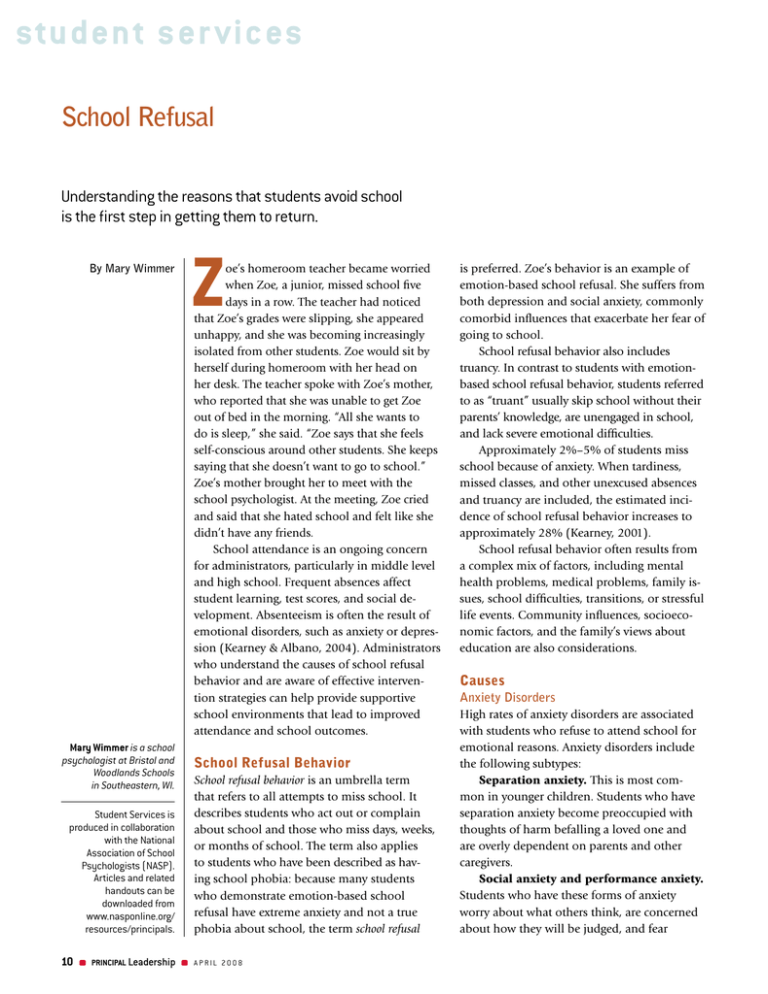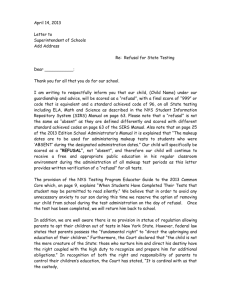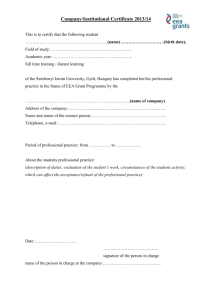Z
advertisement

student ser vices School Refusal Understanding the reasons that students avoid school is the first step in getting them to return. By Mary Wimmer Mary Wimmer is a school psychologist at Bristol and Woodlands Schools in Southeastern, WI. Student Services is produced in collaboration with the National Association of School Psychologists (NASP). Articles and related handouts can be downloaded from www.nasponline.org/ resources/principals. 10 Principal Leadership Z oe’s homeroom teacher became worried when Zoe, a junior, missed school five days in a row. The teacher had noticed that Zoe’s grades were slipping, she appeared unhappy, and she was becoming increasingly isolated from other students. Zoe would sit by herself during homeroom with her head on her desk. The teacher spoke with Zoe’s mother, who reported that she was unable to get Zoe out of bed in the morning. “All she wants to do is sleep,” she said. “Zoe says that she feels self-conscious around other students. She keeps saying that she doesn’t want to go to school.” Zoe’s mother brought her to meet with the school psychologist. At the meeting, Zoe cried and said that she hated school and felt like she didn’t have any friends. School attendance is an ongoing concern for administrators, particularly in middle level and high school. Frequent absences affect student learning, test scores, and social development. Absenteeism is often the result of emotional disorders, such as anxiety or depression (Kearney & Albano, 2004). Administrators who understand the causes of school refusal behavior and are aware of effective intervention strategies can help provide supportive school environments that lead to improved attendance and school outcomes. School Refusal Behavior School refusal behavior is an umbrella term that refers to all attempts to miss school. It describes students who act out or complain about school and those who miss days, weeks, or months of school. The term also applies to students who have been described as having school phobia: because many students who demonstrate emotion-based school refusal have extreme anxiety and not a true phobia about school, the term school refusal april 2008 is preferred. Zoe’s behavior is an example of emotion-based school refusal. She suffers from both depression and social anxiety, commonly comorbid influences that exacerbate her fear of going to school. School refusal behavior also includes truancy. In contrast to students with emotionbased school refusal behavior, students referred to as “truant” usually skip school without their parents’ knowledge, are unengaged in school, and lack severe emotional difficulties. Approximately 2%–5% of students miss school because of anxiety. When tardiness, missed classes, and other unexcused absences and truancy are included, the estimated incidence of school refusal behavior increases to approximately 28% (Kearney, 2001). School refusal behavior often results from a complex mix of factors, including mental health problems, medical problems, family issues, school difficulties, transitions, or stressful life events. Community influences, socioeconomic factors, and the family’s views about education are also considerations. Causes Anxiety Disorders High rates of anxiety disorders are associated with students who refuse to attend school for emotional reasons. Anxiety disorders include the following subtypes: Separation anxiety. This is most common in younger children. Students who have separation anxiety become preoccupied with thoughts of harm befalling a loved one and are overly dependent on parents and other caregivers. Social anxiety and performance a ­ nxiety. Students who have these forms of anxiety worry about what others think, are concerned about how they will be judged, and fear Warning Signs of School Refusal Behavior ­ umiliation. They may have intense anticipah tory anxiety about giving speeches, taking tests, or participating in sports. Generalized anxiety disorder. Students who have generalized anxiety disorder have excessive anxiety and worry about any number of situations and events. They are concerned about their competence, unsure of themselves, and perfectionistic about their school work. They tend to perceive the world as threatening and may experience anxiety about such situations as war or natural disasters. Their anxiety interferes with school performance and can cause fatigue, restlessness, difficulty concentrating, irritability, sleep disturbances, and muscle tension. Other anxiety disorders, such as obsessivecompulsive disorder and post-traumatic stress disorder, can be associated with school refusal behavior. Panic attacks and agoraphobia may also be present. Depression Depression may be the cause of school refusal behavior for some students. Common characteristics of depression in adolescents include depressed mood, lack of interest in activities, irritability, difficulty getting along with others, rebellious or risk-taking behavior, sleep difficulties, physical complaints, fatigue or lethargy, feelings of inadequacy or excessive guilt, difficulty concentrating or indecisiveness, and thoughts of death or suicidal ideation. The presence of depression in school refusers increases the potential for such severe symptoms as self-mutilation, suicidal ideation and suicide attempts, and uncontrolled worry (Kearney & Albano, 2004). Physical Complaints School refusers frequently complain about physical ailments (e.g., headaches or stom- n Frequent unexcused absences n Frequent tardiness nAbsences on significant days (e.g., days on which tests, speeches, or physical education class are scheduled) n Frequent requests to go to the nurse’s office n Frequent requests to call home or to go home during the day achaches) without the presence of a medical condition. Sometimes a legitimate medical concern (e.g., asthma) contributes to a pattern of school refusal behavior. For example, a student’s asthma may be the initial reason for a legitimate school absence. Later, anxiety about returning to school prompts the student to avoid school even after he or she recovers physically. If possible, school personnel should consult with the student’s physician to determine whether a medical condition would preclude the student’s return to school or restrict his or her activities while in school. School Factors and Community Influences School factors that may be associated with school refusal behavior include high absenteeism rates for students and staff members, large groups of low-achieving older students, large class sizes, a high level of discipline problems, low staff morale, an authoritarian style of school management, dependence on students for approval by the staff, negative staff member–student interaction, too much emphasis on competition or testing, school violence, and gang activity. Data from the 2005 Youth Risk Behavior Survey that was conducted by the U.S. Department of Health and Human Services (Eaton et al., 2006) found that in the United States, 6% of students ages april 2008 Principal Leadership 11 student ser vices What Schools Can Do n Educate teachers on the early warning signs of school refusal behavior. n Set up rewards for school attendance. n Work with parents to monitor attendance. n Use a team approach for assessment and intervention for school refusal behavior. n Facilitate access to mental health services. nAddress school safety issues through antibullying and antiviolence initiatives. Family Factors nProvide academic supports for students who refuse school because they have academic difficulties. n Create a welcoming, engaging environment that helps students feel connected to their school and teachers. nProvide a safe place where students can go when feeling stressed or overwhelmed. nAllow for progressive reentry over one or two weeks. n Temporarily allow a flexible school day. n Show sensitivity to students who have performance anxiety. For example, reduce the need for the student to give speeches or provide an alternate test-taking environment. nInvolve families in the school through outreach and after-school programs. n Collaborate with medical or community-based team members. n When other interventions have been unsuccessful, consider part-time schooling for students with extended absences (i.e., over two years) that result from extreme levels of anxiety and depression (Kearney, 2001; Kearney & Bates, 2005). References n Kearney, C. A. (2001). School refusal behavior in youth: A functional approach to assessment and treatment. Washington, DC: American Psychological Association. n Kearney, C. A., & Bates, M. (2005). Addressing school refusal behavior: Suggestions for frontline professionals. Children & Schools, 27, 207–216. 12 Principal Leadership 14–17 missed school on one or more of the 30 days before answering the survey because they felt unsafe at school or on their way to or from school. Clearly, schoolwide initiatives to provide a positive, safe school environment are keys to reducing school avoidance. These include schoolwide antibullying and antiviolence initiatives and increased supervision in the areas of the school where bullying or gang activity is frequent. Students need to feel that they are not alone and that adults at school will help them when they feel unsafe or threatened. april 2008 Parents of students who refuse to go to school for emotional reasons are a diverse group. Some parents are healthy, functioning, and show no psychopathology, but others have their own mental health or lifestyle problems (e.g., dependency, anxiety, depression, substance abuse, high levels of conflict, or emotional detachment) that can contribute to a student’s school refusal behavior. When parental psychopathology is a major contributing factor, intervention strategies should involve the whole family, beginning with mental health services for the parents. The value parents place on education, their involvement in life outside the home, and their attitudes toward mental health and access to mental health services can be factors as well. Other Variables School refusal behavior can be triggered by transitions, ranging from the commonplace, such as vacations and weekends, to milestones, such as the entrance to kindergarten and the transition into the middle level or high school. The most common age for school refusal is early adolescence. Significant events (e.g., a prolonged illness, a move, or the death of a parent) may also trigger school refusal behavior in some students. In other cases, students perceive the work as too hard and see school as the place where they fail. Older students tend to exhibit more-severe problems and greater difficulty returning to school than younger children. Resources Assessment Interventions and Treatment Early assessment of and intervention for school refusal behavior is key to enabling a student to return to school, and a team problem-solving approach is useful. The team can include relevant teachers and administrators, school mental health professionals, the school nurse, the student’s parents, the student’s physician, other relevant community providers, and the student. Team members evaluate the underlying cause of the problem and design a plan specific to the individual student. Assessment tools include interviews, observation, review of records and attendance history, self-reports, b ­ ehavior rating scales, and functional behavioral assessment and analyses. A functional assessment of the school refusal behavior is accomplished by examining antecedents and consequences of the behavior. Kearney and Silverman (1999) outlined four reasons why students refuse to come to school: 1. To avoid situations that cause negative affectivity (e.g., fear, anxiety, depression, or physical complaints) 2. To escape evaluative situations (e.g., tests, speeches, and athletic performances) 3. To gain attention (most common in younger children who have separation anxiety) 4. To pursue a desired activity (e.g., watch television, play video games, or hang out with friends). Students who miss school to pursue a desired activity are typically referred to as truant. Oppositional defiant and conduct disorders may be present and severe behaviors can include chronic noncompliance and aggression (Kearney & Albano, 2004). Strategies for these students often involve family intervention, contracts, increased supervision, and legal avenues for enforcing school attendance. Sometimes a student’s absenteeism is due to other life pressures. Kearney (2001) recommends that school staff members determine whether the student is missing school because of parent-motivated school withdrawal or other factors, such as homelessness, abuse, or pregnancy. Effective intervention for school refusal behavior that is associated with anxiety and depression helps students develop the necessary coping strategies to increase their school attendance. Cognitive-behavioral strategies are used most often and include relaxation and cognitive restructuring (reducing negative self-talk and increasing healthy self-talk), gradual re-entry to school, and rewards for school attendance. Students are taught the following problem-solving steps: recognize when they are stressed, identify their feelings and thoughts, implement healthier thoughts or coping strategies, and reinforce themselves for using coping strategies during difficult situations (Kearney & Albano, 2007). Other strategies may include psychoeducation, social skills training, goal setting, teacher consultation, and parent training. Medication may be used in combination with cognitive-behavioral therapy for students whose school refusal is a result of a psychiatric disorder (Fremont, 2003) and is most appropriate when a student’s anxiety level is extremely high or there are comorbid conditions, such as depression or obsessivecompulsive disorder (Kearney, 2001). Parental involvement is very important to the success of all intervention strategies. School Phobia, Panic Attacks, and Anxiety in Children. M. Csoti. 2003. New York: Jessica Kingsley Publishers. Getting Your Child to Say “Yes” to School. C. A. Kearney. 2007. New York: Oxford University Press. School Refusal: Assessment and Intervention Within School Settings. M. B. Wimmer. 2003. Bethesda, MD: National Association of School Psychologists. School Refusal: Information for Educators. Helping Children at Home and School: Handouts for Families and Educators II. M. B. Wimmer. 2004. Bethesda, MD: National Association of School Psychologists. Forced Attendance or Gradual Reentry? Forced school attendance may be appropriate for students with mild school refusal or younger students (Kearney, 2001). Because forced school attendance can be so stressful, however, a gradual reentry plan is often recommended for older students or students who are extremely anxious or depressed. Gradual reentry may take many steps, from helping the student identify which parts of getting ready for school he or she can and cannot do (e.g., getting up in the morning, getting dressed, leaving for school, and entering the school grounds). The student may respond positively to gradual reentry, such as arriving at school but not going inside on day one, entering the school and visiting the front office on day two, identifying which class is most comfortable and staying in just that class april 2008 Principal Leadership 13 student ser vices The goal of intervention should be to increase attendance and coping skills. A good policy is to act quickly and acknowledge that many factors contribute to school refusal behavior. on day three, and so forth. The student should be helped to identify the staff members with whom he or she feels safest, and those staff members can greet the student and provide a safe harbor. The same can be done with friends or peers. Referral for Truancy Given the legal requirements under compulsory school attendance laws, some students with emotion-based school refusal are referred to the courts for truancy by school officials. Pressure resulting from court referral might be helpful in prompting an evaluation of the student when a student or parent refuses interventions offered by the school or if the family is unable to afford or access mental health services. Successful Outcomes High rates of anxiety disorders have been found in students who refuse to go to school for emotional reasons, and depression may be present in some students. Early assessment and intervention for school refusal behavior is key to successful outcomes. School administrators can support these students by establishing problem-solving teams that can identify, assess, and intervene with school refusers and by promoting strong alliances with families and the community mental health agencies involved in treatment. The goal of intervention should be to increase attendance and coping skills. A good policy is to act quickly and acknowledge that many factors contribute to school refusal behavior. School staff members worked with Zoe’s parents and her psychiatrist to design a gradual school reentry plan. Her ongoing treatment consisted of medication and cognitive-behavioral therapy to increase attendance and reduce anxiety and depression. She learned coping skills for her social anxiety and sees the school psychologist weekly. She joined a group for coping with stress that is facilitated by the school counselor and has developed some friendships within the group. She knows that she can talk to her homeroom teacher or the school psychologist if she is feeling stressed or overwhelmed. PL References Advertisement 14 Principal Leadership april 2008 n Fremont, W. P. (2003). School refusal in children and adolescents. American Family Physician, 68, 1555–1561. n Kearney, C. A. (2001). School refusal behavior in youth: A functional approach to assessment and treatment. Washington, DC: American Psychological Association. n Kearney, C. A., & Albano, A. M. (2004). The functional profiles of school refusal behavior: Diagnostic aspects. Behavior Modification, 28, 147–161. n Kearney, C. A., & Albano, A. M. (2007). When children refuse school: A cognitive- behavioral therapy approach: Therapist guide. San Antonio, TX: The Psychological Corporation. n Kearney, C. A., & Silverman, W. K. (1999). Functionally based prescriptive and nonprescriptive treatment for children and adolescents with school refusal behavior. Behavior Therapy, 30, 673–695. n Eaton, D. K., Kann, L., Kinchen, S., Ross, J., Hawkins, J., Harris, W. A., et al. (2006). Youth risk behavior surveillance–United States, 2005. Morbidity and Mortality Weekly Report, 55. Retrieved from www.cdc.gov/mmwr/PDF/ss/ ss5505.pdf





